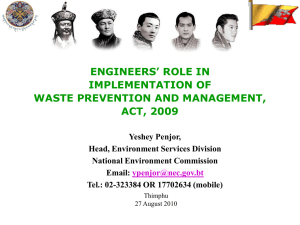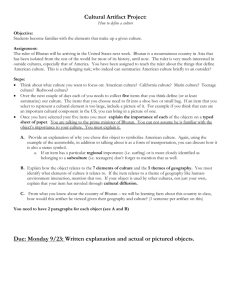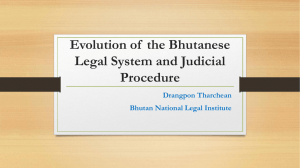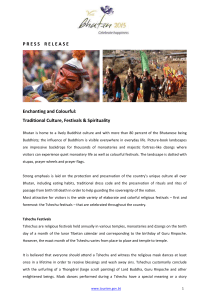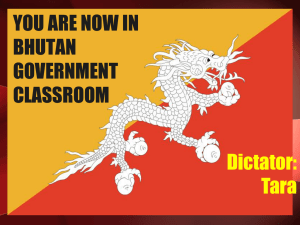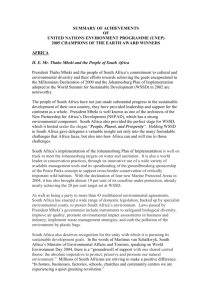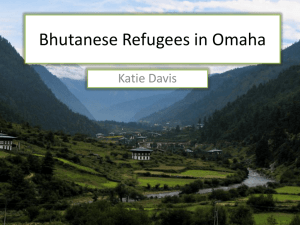Appendix III
advertisement
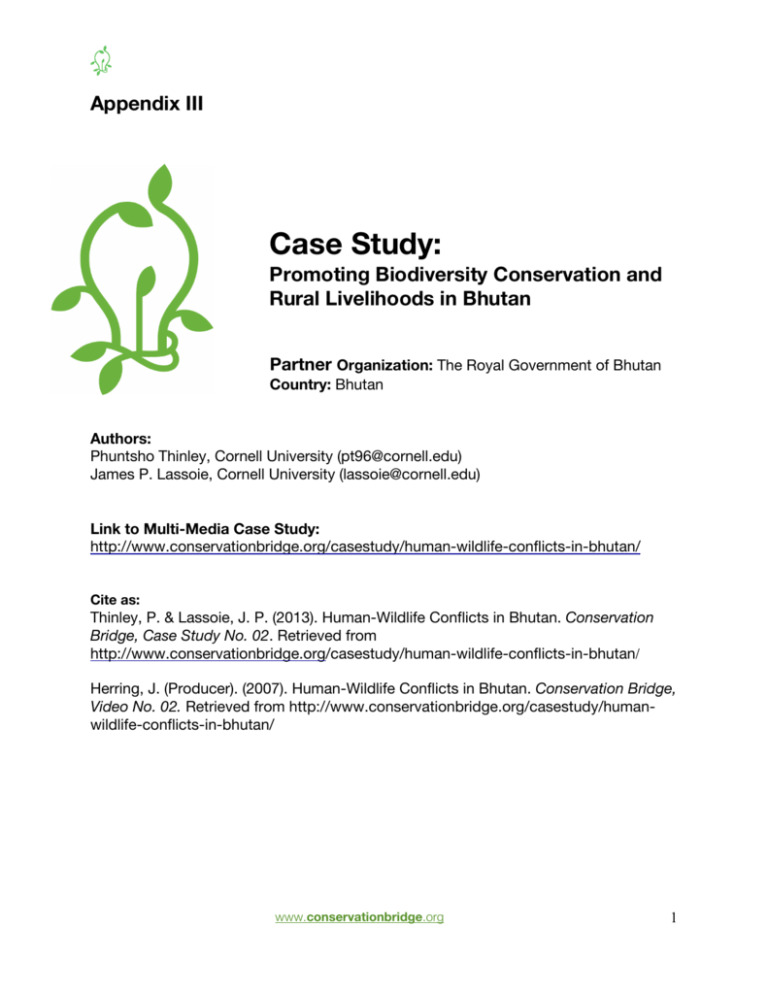
Appendix III Case Study: Promoting Biodiversity Conservation and Rural Livelihoods in Bhutan Partner Organization: The Royal Government of Bhutan Country: Bhutan Authors: Phuntsho Thinley, Cornell University (pt96@cornell.edu) James P. Lassoie, Cornell University (lassoie@cornell.edu) Link to Multi-Media Case Study: http://www.conservationbridge.org/casestudy/human-wildlife-conflicts-in-bhutan/ Cite as: Thinley, P. & Lassoie, J. P. (2013). Human-Wildlife Conflicts in Bhutan. Conservation Bridge, Case Study No. 02. Retrieved from http://www.conservationbridge.org/casestudy/human-wildlife-conflicts-in-bhutan/ Herring, J. (Producer). (2007). Human-Wildlife Conflicts in Bhutan. Conservation Bridge, Video No. 02. Retrieved from http://www.conservationbridge.org/casestudy/humanwildlife-conflicts-in-bhutan/ www.conservationbridge.org 1 About ConservationBridge ConservationBridge connects teachers, students and conservation practitioners through multi-media based case studies. The goal is to bring the science of conservation to life for students through targeted case studies that highlight real-world issues and to provide conservation practitioners with student led research and reports. ConservationBridge is a collaborative effort directed by James P. Lassoie, Department of Natural Resources, College of Agriculture & Life Sciences, Cornell University. This material is based upon work supported by the National Science Foundation under Grant No. 0837489. Any opinions, findings, and conclusions or recommendations expressed in this material are those of the authors and do not necessarily reflect the views of the National Science Foundation. www.conservationbridge.org 2 Promoting Biodiversity Conservation and Rural Livelihoods in Bhutan1 Phuntsho Thinley2 and James P. Lassoie3 Socio-Cultural and Geo-Political Background Located between India and China in South Asia (Figure 1), the Himalayan Kingdom of Bhutan is often dubbed the Last Shangri-La (Hilton, 1933). This mystical county is not well known to the rest of the world - not even to most of the neighboring Indians and Chinese - and remains one of the most isolated and least developed countries in the world (United Nations, 2003). Protected by natural boundaries, such as permanent snow-covered Himalayan Mountains in the north and dense sub-tropical jungles in the south, Bhutan was never colonized by any country. Until its unification under single rule in 1907 by Sir Ugyen Wangchuck, the First Hereditary Monarch, the country was fragmented into petty states. Bhutan joined the United Nations in 1972 under the aegis of India in order to develop stronger connections to the international community. Generations of benevolent kings have ruled the country and continued the policy of fierce protection of its traditional culture, national identity, and unique biodiversity. It was not until 1999 that the government lifted its ban on television and the Internet, making Bhutan one of the last countries in the world to introduce these modern forms of communication. Figure 1. Map of South Asia showing the location of Bhutan (Thinley, 2008). 1 The authors acknowledge the assistance of James Monahan and R. Jamie Herring, Cornell University, in the development of this case study. 2 Deputy Chief Research Officer, Renewable Natural Resource Research and Development Center, Yusipang, Bhutan 3 International Professor of Conservation, Fernow Hall, Department of Natural Resources, College of Agriculture & Life Sciences, Cornell University, Ithaca, NW, USA; JPL4@cornell.edu www.conservationbridge.org 3 Bhutan is not only small geographically (it is only 38,394 km2), but also has a relatively small population of approximately 700,000 people. Now a constitutional democratic country, the king gave up his absolute power in 2006, announcing that the country would have its first democratic elections in Spring 2008 (Sithey, 2013).4 Bhutan's main export is hydroelectricity that accounts for 40% of national revenue and 25% of Gross Domestic Product (Asian Development Bank, 2011). Bhutan's main export partner is India, accounting for almost 88% of its export goods. Bhutan has a rich and unique cultural heritage that has largely remained intact due to its historical isolation from the rest of the world. Bhutanese tradition is deeply rooted in its Buddhist heritage, which greatly emphasizes conservation where the killing of any living being goes against their deeply held religious beliefs. Almost 80% of the population follows Tibetan Buddhism, while 20% ethnic Nepalese who immigrated to the country in the 1950s follow Hinduism. The National Dress for Bhutanese men is the gho, which is a knee-length robe tied at the waist by a cloth belt known as the kera. Women wear an ankle-length dress, the kira, which is clipped at the shoulders and tied at the waist. Bhutanese law requires all Bhutanese citizens to wear the National Dress in government offices, at official functions, and as formal wear. Rural Livelihood More than 70% of Bhutanese live in rural areas (Santos & Ura, 2008) and 60% practice subsistence agriculture based on a combination of crop and livestock production (Dukpa, 2013). All farmers rely on cattle for farmyard manure, as chemical fertilizers are expensive and largely discouraged by local agriculture officers. Due to largely rugged terrains, only 8% of the country is arable. Farmers residing in upland areas above 4,000 meters primarily raise livestock, mostly yak, and grow crops such as wheat and some vegetables. Lowland dwellers grow crops and raise cattle for dairy products. Other domestic animals include horses, poultry, pigs, sheep, and dogs. Rice is the staple diet for all Bhutanese. More than five varieties of rice are grown; the most popular being Bhutanese red rice, which is now imported to the United States. Potatoes, wheat, and corn are the main crops grown in areas where rice cannot be grown due to cold climatic conditions or lack of irrigation. Urban dwellers import rice mostly from India because of the limited supply from its rural areas. The average annual income of a farmer stands at only US $440 (Dukpa, 2013). A traditional rural house is made mostly of wood anchored on mud and stonewalls. Wooden shingles, bamboo, and banana leaves are still used as roofing materials in most rural areas, although galvanized iron sheets are becoming more common. Almost 80% of the villages are supplied with electricity and isolated areas are supplied with solar panels; even so, firewood remains the primary fuel source for cooking and heating purposes. Domestic cattle are rarely stall-fed; instead they are released into the nearby forest to disperse and forage during the day and are then collected back in the evening. A tradition of migratory herding practices persists where yak and cattle are moved to summer pastures in sub-alpine and alpine meadows. Chemical fertilizers are rarely 4 Also see: http://www.kuenselonline.com/democracy-in-bhutan-the-first-five-years/#.Ul_3mhaJtsQ www.conservationbridge.org 4 used. Much of the manure is produced from cow dung and leaf litter composed of dried oak leaves, ferns, and pine needles is used as bedding in animal sheds. Biodiversity Conservation Despite its small size, Bhutan’s astounding wealth of biodiversity is unparalleled in the region, and is thus a global biodiversity hotspot (Ministry of Agriculture and Forests [MoAF], 2009). Endowed with 73% forest cover (MoAF, 2010), Bhutan is home to a variety of charismatic and globally important wildlife species. A list of 90 mammals found in the country (Wangchuk et al., 2004) includes the globally endangered carnivores – the Royal Bengal tiger (Panthera tigris), snow leopard (Panthera uncia), and dhole (Cuon alpinus); and the near threatened common leopard (Panthera pardus). Other charismatic cat species such as marbled cat (Pardofelis marmorata), clouded leopard (Neofelis nebulosa), Asiatic golden cat (Pardofelis temminckii), and Pallas’s cat (Octocolobus manul) are also found in many parts of the country (Thinley, 2013a; Wang, 2010). Two species of bears are found in Bhutan: Asiatic black bear (Ursus thibetanus) and sloth bear (Melursus ursinus). Numerous native herbivores serve as important prey for these wild predators. In areas below 4000 meters, the most prominent are sambar (Rusa unicolor), wild pig (Sus scrofa), muntjak (Muntiacus muntjac), hog deer (Hyelaphus porcinus), the critically endangered pygmy hog (Porcula salvania), Himalayan musk deer (Moshus leucogaster), gaur (Bos gaurus) and water buffalo (Bubalus bubalis). Blue sheep (Pseudois nayaur) and marmots (Marmota himalayana) are found above 4000 meters (Thinley, 2013b; Wang, 2010). Some endemic species such as the Bhutan takin (Budorcas taxicolor whitei) and golden langur (Trachypithecus geei) occur in Jigme Dorji National Park and Royal Manas National Park, respectively (see Figure 2). Other mega-herbivores such as the Asian elephant (Elephas maximus) and onehorned Indian rhinoceros (Rhinoceros unicornis) are found along the southern foothills. Sightings of some charismatic herbivores such as red panda (Ailurus fulgens), capped langur (Trachypithecus pileatus), and common grey langur (Semnopithecus entellus) are cherished by villagers and tourists. Bhutan is also well known for its large bird diversity, and is sometimes called a “birder’s paradise” in the Himalayas. Almost 770 species of birds currently are confirmed present (MoAF, 2009). Several species are critically endangered as per IUCN’s Redlist of 2013, including Baer’s Porchard (Aythya baeri), white-bellied heron (Ardea insignis), and white-rumped vulture (Gyps bengalensis). The vulnerable blacknecked crane (Grus nigricolis) winters in Bhutan from November to February. An astonishing array of plant life also exists in Bhutan because of the country’s very steep elevation gradient, with land rising from 150 meters above sea level in the southern foothills to about 7,700 meters in the northern greater Himalayas. There are over 5,603 plant species, including 200 species of medicinal plants, more than 369 species of orchids, and 46 species of rhododendrons (MoAF, 2009). Pastoralists in the uplands supplement their incomes from livestock rearing by collecting and selling valuable and highly sought medicinal plants, such as the Chinese caterpillar (Ophiocordyceps sinensis) fungus. www.conservationbridge.org 5 Like the “Forever Green Clause” in the New York State Constitution, Bhutan’s Constitution mandates the government to maintain a minimum of 60% forest cover eternally (MoAF, 2010). The country’s park system has been touted as being one of the most complete and overarching conservation systems in the world – 50% of the country is in protected areas comprised by a system of five parks, four wildlife sanctuaries, one strict nature reserve, and a network of migration corridors to connect them (Figure 2). Most protected parks in Bhutan support some form of land use such as agriculture, livestock grazing, and/or harvesting of timber and non-timber products solely for domestic uses (Wang & Macdonald, 2006). The Department of Forest and Park Services under the Ministry of Agriculture and Forests runs the park system. Environmental conservation is afforded the highest priority in Bhutan due to the fragile nature of the young Himalayan Mountains and steep terrains. The National Environment Commission oversees the issuance of Environmental Clearance and regulates Environmental Impact Assessment, which is mandatory for the approval of all developmental activities. The National Biodiversity Centre under the Ministry of Agriculture and Forests is in charge of ex-situ Figure 2. Map of Bhutan’s protected areas network prepared by Department of Forests & Park Services, Thimphu, Bhutan. conservation of biodiversity through establishment of germplasm and botanical gardens. The Wildlife Conservation Division that oversees the conservation of wild animals throughout the country is also in the Ministry under the Department of Forest and Park Services. In 1992 Bhutan established the world’s first governmentwww.conservationbridge.org 6 independent environmental trust fund5, called the Bhutan Trust Fund for Environmental Conservation, as an innovative mechanism for financing conservation initiatives. Historically, Bhutan has enjoyed tremendous political will and support from the government and its monarchs. Such support is epitomized by the most revered Fourth King, Jigme Singye Wangchuk (1972-2006), who once said, “For centuries Bhutanese have treasured the natural environment and have looked upon it as the source of all life. This traditional reverence for nature has delivered us into the 20th Century with an environment still richly intact. We wish to continue living in harmony with nature and to pass on this rich heritage to our future generations.” Gross National Happiness: Bhutan’s Sustainable Development Philosophy Gross National Happiness (GNH) is an attempt to define development in more holistic and psychological terms than Gross National Product, which is not necessarily indicative of a country’s environmental stewardship (Ura & Galay, 2004). Bhutan’s King Jigme Singye Wangchuck coined the term in 1972. It signalled his commitment to building a sustainable economy that seeks to preserve the harmonious synergy between Bhutan's unique culture based on Buddhist spiritual values and preservation of nature. Although often misunderstood and unfairly critiqued by both nationals and internationals, the core of this philosophy is to ensure environmental protection while also pursuing economic development. While conventional development models stress economic growth as the ultimate objective, the concept of GNH is based on the premise that true development of human society takes place when material and spiritual development occur side by side within a healthy natural environment to complement and reinforce each other. The four pillars of GNH are the promotion of equitable and sustainable socio-economic development, preservation and promotion of cultural values, conservation of the natural environment, and establishment of good governance (Fishman, 2010). Like many moral goals, GNH is somewhat easier to state than it is to define. Nonetheless, it serves as a unifying vision for all governmental planning documents that guide sustainable development in the country. Sustainable Tourism Bhutan started tourism in 1974 – with 287 tourists – coinciding with the year when the Fourth King was crowned. Since then, the number of tourists visiting the country was carefully controlled by the state with the principle of “high value – low volume” (Department of Tourism [DoT], 2002). Tourists are allowed to visit Bhutan only through government licensed tour operators who arrange visas, itineraries, guides, and logistics. State control of tourism is deemed necessary because it is believed that uncontrolled, liberalized tourism would overburden Bhutan’s limited facilities and erode its culture and environment (Rinzin, Vermeulun, & Glasbergen, 2007). As of 2013, each tourist is required to spend US $250 per day during the peakseason and US $200 a day off-season (January, June, July) (Tourism Council of Bhutan, 2013). A $65 royalty is taken by the government that goes directly to the 5 see: http://www.bhutantrustfund.bt www.conservationbridge.org 7 national exchequer from where it is distributed to various government sectors. Many prospective visitors are shocked by this amount, but it is considered reasonable because it covers all expenses, including food, comfortable lodging, a trained guide, and safe transportation. The main intentions behind such a strategy are to: (1) attract visitors who are genuinely interested in learning about Bhutan, (2) provide quality service to visitors, and (3) ensure minimal impact on the country’s culture and environment. Despite such a high tariff, the number of tourists has steadily increased yearly with 2012 recording the highest number to date (105,407 arrivals). Bhutan has been consistently rated as one of top ten tourist destinations in the world. Due to increasing numbers of tourists each year, the government had to change the operating principle to “high value – low impact”, which is still highly appreciated by international communities. Many new trekking routes have been opened and new hotels and resorts have been built and upgraded to accommodate the growing number of visitors. The tourism industry in Bhutan is the second highest contributor to Gross Domestic Product, next to hydropower, contributing US $90 million in 2010 (International Trade Center, 2011) and US $152 million in 2011 (Dema, 2013). Tourism in Bhutan is mostly nature and culture based. Tourists come to primarily witness distinctive Bhutanese culture and biodiversity, not to watch international sports or attend music or film festivals. In recent years, some have come to seek traditional medical treatments. Also recently, special interest tourists come for river rafting, fly fishing, mountain biking, rock climbing, and bird watching. Some are Buddhist pilgrims from Asia and the United States (Rinzin et al., 2007). Most tour itineraries have a good mix of cultural visits and short nature treks. There are some tourists who come exclusively to trek in the country’s national parks, and the 49-day Snowmen Trek is highly popular among international trekkers. Essentially, Bhutan’s tourism is largely ecotourism that encompass ecological, economic, and social aspects (Gurung & Seeland, 2008). Realizing the importance of local participation in the tourism, several communitybased ecotourism groups have been initiated. The oldest one, established in 2006, is Nabji-Korphu Community-Based Ecotourism in Jigme Singye Wangchuck National Park, where villagers organize the logistics and stage cultural shows to tourists. Human-Wildlife Conflicts6 Modern conservation in Bhutan started in 1993 with the development of a system of protected areas and the establishment of a legal framework for conservation, the Forest and Nature Conservation Act of 1995. Farmers were allowed to remain in protected areas, but those accustomed to having free access to natural resources had to change their lifestyles because there were restrictions on traditional resource uses, bans on shifting cultivation (Namgyal, Siebert, & Wang, 2008) and hunting7, enforced limitations on extractions of timber and non-timber forest products, and limitations on 6 Modified and updated from Lassoie, 2008 Despite Buddhist beliefs against the killing of animals, wildlife hunting for food may have been common before 1995. However, its historical extent is difficult to assess because of a strong social stigma associated with hunting, and now being illegal, an accurate estimate of its occurrence is even more difficult to obtain. 7 www.conservationbridge.org 8 grazing in community and reserve forests. In addition, development projects in protected areas were to include stringent environmental impact assessments and had to be non-commercial. Subsequent increases in wildlife populations resulted in increased threats to humans, crops, and livestock (Choden & Namgay, 1996; Wang, Curtis, & Lassoie, 2006; Wang & Macdonald, 2006) and conflicts between local people and park management officials (Wang et al., 2006; Wang & Macdonald, 2006). There is ample evidence to support growing concern that these conflicts have increased over the past two decades. More and more cases of livestock predation by wild predators and crop depredation by wild herbivores are constantly featured in the national newspaper.8 Annual crop loss ranges from 0.3 to 18% of total household income, and on average farmers spend about two months per year guarding their maize and rice from wildlife (Choden & Namgay, 1996). Guarding, which is mostly done at night, costs farmers untold hardships, additional expenses, and possible personal injury (Choden & Namgay, 1996). In the mid-1990s, 23% of the farmers in Zhemgang District had stopped growing rice, while 39% had abandoned dry land agriculture and 71% had stopped slash and burn agriculture because of crop damage (van Aaken, 1997). While in Tomiyangtse (eastern district of Tashi Yangtse), 14% of the workforce had emigrated in search of non-farming work (Doe, 1996). Direct encounters with potentially dangerous wildlife can have disastrous outcomes. For example, two men were killed in 1996 while chasing wild pigs (Sus scrofa) (Choden & Namgay, 1996) and human deaths and injuries have been reported following attacks by Himalayan black bears (Ursus thibettanus).9 One leopard (Panthera pardus) killed 40 livestock during one month (Wang, 2001), and a pack of dholes (Cuon alpinus) killed 24 mules, six cattle, and two yaks in Jigme Dorji National Park in nine months in 2003 (Wang, 2008). In the early 1980s, widespread concern about heavy livestock depredation by dholes prompted the government to distribute zinc phosphate tablets to farmers, which led to the eradication of almost the entire population of this key predator through mass poisoning of livestock carcasses. This apparently contributed to a sharp increase in the abundance of wild pigs, which are now the species most responsible for crop damage in Bhutan, and programs are now being initiated to increase dhole populations for their control (Thinley et al., 2011; Wang et al., 2006). Ironically, however, a standing Royal Command still maintains a bounty on dholes, and anyone producing a tail will receive a reward from the Department of Forests and Park Services. The most complete examination of human-wildlife conflicts to date in Bhutan has been in Jigme Singye Wangchuck National Park (JSWNP). Recently some studies have also been conducted in Jigme Dorji National Park (e.g., Thinley et al., 2011). Based on a stratified-random sample of 274 farmers living in JSWNP, most had suffered major financial losses annually due to crop damage by wild pigs, barking deer (Muntiacus muntjak), macaques (Macaca mulatta), and sambars (Cervus unicolor) (Wang et al., 8 e.g., see: http://www.kuenselonline.com/wildlife-the-bane-of-farming/#.Ul_6VRaJtsQ and http://www.kuenselonline.com/triple-the-number-of-wild-boars-this-year/ - .Ul_7UBaJtsQ 9 e.g., see: http://www.raonline.ch/pages/bt/nat/bt_bear01d.html www.conservationbridge.org 9 2006). All respondents reported crop losses to wild animals, with wild pig being the most common cause (97%). Farmers responded by implementing non-lethal methods such as guarding, fencing, and performing religious rituals to protect their crops. Farmers also reported livestock depredation by wild carnivores including leopard, tiger, Himalayan black bear, and dhole (Wang & Macdonald, 2006). Over 20% of households surveyed reported losses to wild predators totaling 2.3% of their domestic animals over the past year. This loss equated to an average annual financial loss equal to 17% (US $44.72) of their total per-capita cash income. Total reported losses during 2000 amounted to US $12,252, of which leopard and tiger kills accounted for 82% (US $10,047). Annual mean livestock loss per household (of those that reported loss) was 1.29 head of stock, equating to more than two-thirds of their annual cash income of US $250. Lax herding, inadequate guarding practices, and overgrazing may have contributed to livestock losses. Approximately 60% of the households lacked proper stables for corralling their livestock at night and there was a significant correlation between the number of livestock lost and the distance between the household and the grazing pasture. The same survey also assessed farmers’ perceptions of the influence of park management policies and protection regimes on traditional resource uses, and their attitudes toward the park and conservation policies set forth in the Forest and Nature Conservation Act of 1995, integrated conservation development programs (ICDPs)10, and wildlife conservation, and determined how demographic and socio-economic variables influence these attitudes (Wang & Macdonald, 2006). Among local farmers, over half disliked the park and the Conservation Act, and almost 68% supported exterminating problem wildlife. Negative attitudes were linked to loss of resource use rights, livestock depredation and crop damage, lack of compensation strategies, and exclusion of farmers from the park’s planning processes. However, over 75% of the respondents appreciated the park’s development programs, the positive attitudes associated with an expectation that significant economic benefits would be available from ICDPs sponsored by the park authorities. Empowerment of local communities associated with monetary benefits from non-timber forest products and compensation for loss of crops and livestock were emphasized by more than 70% of the respondents. These attitudes were related to age and literacy of the respondents, number of livestock owned, and size of land holdings. The Challenges to Biodiversity Conservation Conservation policies that restrict traditional land uses and/or increase losses of livestock, crops, and human life to wildlife will cause antagonistic feelings in the very people who once were stewards of the land (Conover, 2002; Mehta & Kellert, 1998; Mordi, 1991; Woodroffe et al. 2005), potentially compromising the future of conservation and protected areas (Bhatnagaer et al., 2000; Naughton-Treves, 1998; Straede & Helles, 2000). For example, with livelihoods threatened, local people often retaliate by killing wildlife, and may lose confidence in the conservation efforts being promoted by the government and various non-governmental organizations, often 10 e.g., see: http://wwf.panda.org/who_we_are/wwf_offices/bhutan/projects/index.cfm?uProjectID=BT0874 www.conservationbridge.org 10 leading to further negative impacts on wildlife and their habitats (Woodroffe et al., 2005). Hence, understanding human attitudes and the potential for wildlife conflicts in the context of protected area management is critically important in designing long-term conservation strategies (Heinen, 1993; Mordi, 1991). This is certainly the situation now facing the Royal Government of Bhutan, as it grapples with increasing wildlife-human conflicts that were minimal two decades ago. This likely reflects increased incidences of large-scale crop damage by wild pigs in the 1990s after the mass killing of dholes, which failed as a management practice for reducing livestock predation. In addition, the total protection of wildlife species by the Forest and Nature Conservation Act of 1995 has changed the perception of people from treating tigers and leopards as being part of their natural landscape to being properties of the state, and hence the government’s complete responsibility. Therefore, any inaction on their part to control human-wildlife problems is now considered as being irresponsible and causing unnecessary suffering to rural citizens. People, who once tolerated livestock losses as being natural, have grown to expect financial compensation from the state for such losses. Unfortunately, government-sponsored compensation programs have proven costly and difficult to administer. It is too early to assess the success of community-based livestock compensation programs implemented in 2012 using money provided by the Bhutan Trust Fund for Environmental Conservation’s Human-wildlife Conflict Mitigation Fund. Despite the predominant Buddhist ethic in Bhutan, human-wildlife conflicts remain the main threat to conservation of biodiversity. Farmers who tolerated wildlife damages in the past have now come forward demanding action by the government, and wildlife conflicts are impacting the government’s objective of increasing food security and jeopardizing the future of Bhutan’s conservation programs (Wang et al., 2006; Wang & Macdonald, 2006). The voices of farmers have become more pronounced after Bhutan became parliamentary democracy in 2008, and the need to resolve human-wildlife conflicts has persistently surfaced in the National Assembly (Lower House) and the National Council (Upper House). Being a largely agrarian country marked by undeveloped and biodiversity-rich rural landscapes, human-wildlife conflicts are inevitable. The close proximity of agricultural lands to dense forest habitats predisposes crops to damage by wild herbivores. According to a recent study by Thinley (2013b), the density of major crop raiders were found to be always higher near croplands than in more remote forested areas. Rapid urbanization and changing governmental policies also have exacerbated human-wildlife conflicts. For example, farmers are now facing acute labor shortages because of rural-urban migration and the state requiring all children to be enrolled in school. Most cattle, which used to be herded by juveniles, are now released to graze unguarded in forests during the day. This is rendering domestic animals more vulnerable to predation by large cats and bears (Thinley, 2013b). In addition, the country’s rapid economic development in the form of increased rural road construction and electrification is destroying wildlife habitats and disrupting wild animal behavior, thus forcing some into human settlements in search of easily accessible food. www.conservationbridge.org 11 While the nation’s increasing human-wildlife conflicts are widely recognized and addressed by the Government of Bhutan11, there is paucity of ecological information on the underlying causes of these conflicts. This lack of understanding is a major hindrance to protected area managers preventing them from effectively dealing with wildlife damages and finding solutions to these problems (Thinley, 2013b). The lack of adequate scientific information is aggravated by farmers’ poor understanding of the ecological significance of wild predators-prey relationships, which potentially hinders attempts to curb retaliatory killing of wild predators and poaching of wild animals. While the Forest and Nature Conservation Act of 1995 prohibits the hunting of all wild animals, farmers are legally permitted to kill problem animals not strictly protected under its Schedule I if they are within 300 meters of their agricultural fields. Unfortunately, a lucrative international market is currently increasing the poaching of high value animals, such as tiger, leopard, rhino, elephant, musk deer, and bear, across the country.12 Bhutan is a unique world resource, rich in natural wonders and cultural identity. However, human-wildlife conflicts remain a recalcitrant problem for its famers and the country’s conservation community, which includes international non-governmental organization such as the World Wildlife Fund. How these problems will be resolved under Bhutan’s new parliamentary democracy is yet to be resolved. References Cited Asian Development Bank. (2011). Case story on cross-border power export from Dagachhu Hydropower Development. Manila, Philippines: Asian Development Bank. Bhatnagaer, Y. V., Stakrey, R.W., & Jackson, R. (2000). A Survey of Depredation and Related Wildlife-Human Conflicts in the Hemis National Park, Ladakh (India). Snow line. Bellevue, Wash., U.S.A: International Snow Leopard Trust. Conover, M. R. (2002). Resolving human-wildlife conflicts. Boca Raton, Florida, U.S.A.: Lewis Publishers. Dema, K. (2013, January 25). Projected target surpassed. Kuensel Online http://www.kuenselonline.com/projected-target-surpassed/#.UnK34pTTXFE Department of Tourism. (2002). Bhutan national ecotoursim strategy. Thimphu: Bhutan. Department of Tourism, Ministry of Trade and Industry. Gurung, D. B., & Seeland, K. (2008). Ecotourism in Bhutan: Extending its benefits to rural communities. Annals of Tourism Research, 35, 489-508. Heinen, M. N. (1993). Park-people relations in Kosi Tappu wildlife reserve, Nepal: Socioeconomic analysis. Environmental Conservation, 20, 24-34. International Trade Center. (2011). Bhutan: A model for sustainable tourism development. International Trade Forum Magazine. Retrieved From http://www.intracen.org/Bhutan-A-model-for-sustainable-tourism-development/ 11 e.g., see: http://www.kuenselonline.com/irrigation-human-wildlife-conflict-will-continue-to-be-aconcern/#.UmAEOBaJtsQ 12 e.g., see: http://www.kuenselonline.com/poaching-fire-are-biggest-threats-to-protected-areas/#.UmAI0haJtsQ www.conservationbridge.org 12 Mehta, J. N., & Kellert, S.R. (1998). Local attitudes toward community-based conservation policy and programs in Nepal: A case study in the Makalu-Barun Conservation Area. Environmental Conservation, 25, 320-333. Ministry of Agriculture and Forests. (2009). Biodiversity action plan 2009. Thimphu, Bhutan: Kuensel Corporation. Ministry of Agriculture and Forests. (2010). National forest policy of Bhutan 2010. Thimphu, Bhutan: Kuensel Corporation. Ministry of Agriculture and Forests. (2013). Bhutan RNR statistics 2012. Thimphu: Bhutan. Mordi, A. R. (1991). Attitudes toward wildlife in Botswana. New York, U.S.A: Garland Publishing, Inc.. Namgyal, U., Siebert, S.F., & Wang, S.W. (2008). Shifting cultivation and biodiversity conservation in Bhutan. Conservation Biology, 22, 1349-1351. National Plant Protection Center. Ministry of Agriculture. Royal Government of Bhutan. (1996). Report on the findings and recommendations of the wild boar survey. Report by Choden, D., & Namgay, K. Thimphu, Bhutan. Naughton-Treves, L. (1998). Predicting patterns of crop damage by wildlife around Kibale National Park, Uganda. Conservation Biology, 12, 156-168. Regional Plant Protection Centre. (1996). Wild boar management report. (Second Half Year Report). Khangma, Trashigang: Bhutan. Report by Doe, D. Rinzin, C., Vermeulun, W. J. V., & Glasbergen, P. (2007). Ecotourism as a mechanism for sustainable development: The case of Bhutan. Environmental Sciences, 4, 109-125. RPCC/RNRC-Plant Protection Centre, (1997). Conclusive report on the 1996/1997 activities under the IPMDP Wild Boar Management Program. Bajo, Wangduephodrang, Bhutan: RPCC/RNRC-Plant Protection Centre. Report by van Aaken, R.. Santos, M. E., & Ura, K. (2008). Multidimensional poverty in Bhutan: Estimates and policy implications. Journal of Bhutan Studies, 18, 1-47. Straede, S., & Helles, F. (2000). Park-people conflict resolution in Royal Chitwan National Park, Nepal: Buying time at high cost? Environmental Conservation, 27, 368-381. Thinley, P. (2008). Design and application of a new conservation paradigm to tiger conservation in Bhutan. Natural Resources. Cornell University, Ithaca, New York, United States. Thinley, P. (2013a). First photographic evidence of a Pallas’s cat in Jigme Dorji National Park, Bhutan. CatNews, 58, 27-28. Thinley, P. (2013b). Ecological Solution to Human-Wildlife Conflicts in a Multifunctional Landscape: Conserving Large Sympatric Carnivores to Maintain Harmonious Coexistence. (Unpublished doctoral dissertation). Cornell University, Ithaca, NY. Thinley, P., Kamler, J. F., Wang, S.W., Lham, K., Stenkewitz, U., & Macdonald, D.W. (2011). Seasonal diet of dholes (Cuon alpinus) in northwestern Bhutan. Mammalian Biology, 76, 518-520. Tourism Council of Bhutan. (2013). Minimum Daily Package. Thimphu, Bhutan: Toursim Council of Bhutan. www.conservationbridge.org 13 United Nations. (2003). Asian Least Developed Countries. New York, U.S.A.: UNOHRLLS. Wang, S. W. (2010). Estimating population densities and biomass of ungulates in the temperate ecosystem of Bhutan. Oryx, 44, 376-382. Wang, S. W., Curtis, P.D., & Lassoie, P. (2006). Farmer perceptions of crop damage by wildlife in Jigme Singye Wangchuck National Park, Bhutan. Wildlife Society Bulletin, 34, 359-365. Wang, S. W., & Macdonald, D. W., (2006). Livestock predation by carnivores in Jigme Singye Wangchuck National Park, Bhutan. Biological Conservation, 129, 558565. Wangchuk, T., Thinley, P., Tshering, K., Tshering, C., Yonten, D., Pema, B., & Wangchuk, S. (2004). A field guide to the mammals of Bhutan. Thimphu, Bhutan: Royal Government of Bhutan. Woodroffe, R., Lindsey, P., Romañach, S., Stein, A., & ole Ranah, S.M.K. (2005). Livestock predation by endangered African wild dogs (Lycaon pictus) in northern Kenya. Biological Conservation, 124, 225-234. www.conservationbridge.org 14
